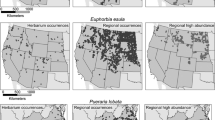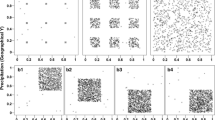Abstract
Predictive modelling techniques using presence-only data have attracted increasing attention because they can provide information on species distributions and their potential habitat for conservation and ecosystem management. However, the existing predictive modelling techniques have several limitations. Here, we propose a novel predictive modelling technique, Limiting Variable and Environmental Suitability (LIVES), for predicting the distributions and potential habitats of species using presence-only data. It is based on limiting factor theory, which postulates that the occurrence of a species is only determined by the factor that most limits its distribution. LIVES predicts the suitability of a candidate grid cell for a species in terms of limiting environmental factor. It also predicts the most limiting factor or the potential limiting factor at the grid cell. The environmental factors can be climatic, geological, biological and any other relevant environmental factors, whether quantitative or qualitative. The predicted habitats consist of the current distribution of the species and the potentially suitable areas for the species where there is currently no record of occurrence. We also compare several properties of LIVES and other predictive modelling techniques. On the basis of 1,000 simulations, the average predictions of LIVES are more accurate than the two other commonly used modelling techniques (BIOCLIM and DOMAIN) for presence-only data.




Similar content being viewed by others
References
Anderson RP, Martinez-Meyer E (2004) Modeling species’ geographic distributions for preliminary conservation assessments: an implementation with the spiny pocket mice (Heteromys) of Ecuador. Biol Conserv 116:167–179
Austin MP (2002) Spatial prediction of species distribution: an interface between ecological theory and statistical modelling. Ecol Modell 157:101–118
Austin MP, Meyers JA (1996) Current approaches to modelling the environmental niche of eucalypts: implication for management of forest biodiversity. For Ecol Manage 85:95–106
Bergengren JC, Thompson SL, Pollard D, DeConto RM (2001) Modeling global climate-vegetation interactions in a doubled CO2 world. Clim Change 50:31–75
Berry PM, Dawson TP, Harrison PA, Pearson RG (2002) Modelling potential impacts of climate change on the bioclimatic envelope of species in Britain and Ireland. Glob Ecol Biogeogr 11:453–462
Bio AMF, De Becker P, De Bie E, Huybrechts W, Wassen M (2002) Prediction of plant species distribution in lowland river valleys in Belgium: modelling species response to site conditions. Biodivers Conserv 11:2189–2216
Boyce MS, Vernier PR, Nielsen SE, Schmiegelow FKA (2002) Evaluating resource selection functions. Ecol Modell 157:281–300
Busby JR (1986) A biogeoclimatic analysis of Nothofagus cunninghamii (Hook.) Oerst. in southeastern Australia. Aust J Ecol 11:1–7
Busby JR (1991) BIOCLIM—a bioclimate analysis and prediction system. In: Margules CR, Austin MP (eds) Nature conservation: cost effective biological surveys and data analysis. CSIRO, Australia, Canberra, pp 64–68
Carpenter G, Gillison AN, Winter J (1993) DOMAIN: a flexible modelling procedure for mapping potential distributions of plants and animals. Biodivers Conserv 2:667–680
Cawsey EM, Austin MP, Baker BL (2002) Regional vegetation mapping in Australia: a case study in the practical use of statistical modelling. Biodivers Conserv 11:2239–2274
Elith J, Burgman M (2002) Predictions and their validation: rare plants in the Central Highlands, Victoria, Australia. In: Scott JM, Heglund PJ, Morrison ML, Haufler JB, Raphael MG, Wall WA, Samson FB (eds) Predicting species occurrences: issues of accuracy and scale. Island Press, Washington, pp 303–313
Elith J, Graham CH, Anderson RP, Dulik M, Ferrier S, Guisan A, Hijmans RJ, Huettmann F, Leathwick JR, Lehmann A, Li J, Lohmann LG, Loiselle BA, Manion G, Moritz C, Nakamura M, Nakazawa Y, Overton JM, Peterson AT, Phillips SJ, Richardson K, Scachetti-Pereira R, Schapire RE, Soberon J, Williams S, Wisz MS, Zimmermann NE (2006) Novel methods inprove prediction of species’ distrbutions from occurrence data. Ecography 29:129–151
Engler R, Guisan A, Rechsteiner L (2004) An improved approach for predicting the distribution of rare and endangered species from occurrence and pseudo- absence data. J Appl Ecol 41:263–274
Farber O, Kadmon R (2003) Assessment of alternative approaches for bioclimatic modeling with special emphasis on the Mahalanobis distance. Ecol Modell 160:115–130
Fielding AH, Bell JF (1997) A review of methods for the assessment of prediction errors in conservation presence/absence models. Environ Conserv 24:38–49
Franklin J (1998) Predicting the distributions of shrub species in southern California from climate and terrain-derived variables. J Vegetation Sci 9:733–748
Fulton J (1999) Using science to advocate action on climate change. Ecosyst Health 5:110–117
Greig-Smith P (1983) Quantitative plant ecology. Blackwell Scientific Publication, Oxford
Guisan A, Zimmermann NE (2000) Predictive habitat distribution models in ecology. Ecol Modell 135:147–186
Guisan A, Weiss SB, Weiss AD (1999) GLM versus CCA spatial modeling of plant species distribution. Plant Ecol 143:107–122
Hansen AJ, Neilson RP, Dale VH, Flather CH, Iverson LR, Currie DJ, Shafer S, Cook R, Bartlein PJ (2001) Global change in forests: responses of species, communities, and biomes. Bioscience 51:765–779
He HS, Mladenoff DJ, Gustafson EJ (2002) Study of landscape change under forest harvesting and climate warming-induced fire disturbance. For Ecol Manage 155:257–270
Hijmans R, Guarino L, Jarvis A, O’Brien R, Mathur P, Bussink C, Cruz M, Barrantes I, Rojas E (2005) DIVA-GIS, Version 5.2, Manual. http://www.diva-gis.org/docs/DIVA-GIS5_manual.pdf
Hilbert DW, Ostendorf B (2001) The utility of artificial neural networks for modelling the distribution of vegetation in past, present and future climates. Ecol Modell 146:311–327
Hilbert DW, Bradford M, Parker T, Westcott DA (2004) Golden bowerbird (Prionodura newtonia) habitat in past, present and future climates: predicted extinction of vertebrate in tropical highlands due to global warming. Biol Conserv 116:367–377
Hilbert DW, van den Muyzenberg J (1999) Using an artificial neural network to characterize the relative suitability of environments for forest types in a complex tropical vegetation mosaic. Divers Distrib 5:263–274
Hirzel AH, Arlettaz R (2003) Modeling habitat suitability for complex species distributions by environmental-distance geometric mean. Environ Manage 32:614–623
Hirzel AH, Helfer V, Metral F (2001) Assessing habitat-suitability models with a virtual species. Ecol Modell 145:111–121
Hirzel AH, Hausser J, Chessel D, Perrin N (2002) Ecological-niche factor analysis: how to compute habitat-suitability maps without absence data? Ecology 87:2027–2036
Horn HS (1985) The ecology of natural disturbance and patch dynamics. Science 230:434–435
Hughes L (2003) Climate change and Australia: trends, projections and impacts. Austral Ecol 28:423–443
Iverson LR, Prasad A, Schwartz MW (1999) Modeling potential future individual tree-species distributions in the eastern United States under a climate change scenario: a case study with Pinus virginiana. Ecol Modell 115:77–93
Leathwick JR (1998) Are New-Zealand’s Nothofagus species in equilibrium with their environment? J Vegetation Sci 9:719–732
Manel S, Dias JM, Buckton ST, Ormerod SJ (1999) Alternative methods for predicting species distribution: an illustration with Himalayan river birds. J Appl Ecol 36:734–747
Margules CR, Austin MP (eds) (1991) Nature conservation: cost effective biological surveys and data analysis. CSIRO, Australia, Canberra
Margules CR, Pressey RL (2000) Systematic conservation planning. Nature 405:243–253
Miller J, Franklin J (2002) Modeling the distribution of four vegetation alliances using generalized linear models and classification trees with spatial dependence. Ecol Modell 157:227–247
Nix H (1986) A biogeographic analysis of Australian elapid snakes. In: Longmore R (ed) Atlas of Elapid Snakes of Australia. Australian Government Publishing Service, Canberra, pp 4–15
Odum EP (1997) Ecology: a bridge between science and society. Sinauer Associates, Massachusetts
Phillips SJ, Anderson RP, Schapire RE (2006) Maximum entropy modelling of species geographic distributions. Ecol Modell 190:231–259
Prentice IC, Cramer W, Harrison SP, Leemans R, Monserud RA, Solomon AM (1992) A global biome model based on plant physiology and dominance, soil properties and climate. J Biogeogr 19:117–134
R Development Core Team (2004) R: a language and environment for statistical computing. R Foundation for Statistical Computing, Vienna
Scott JM, Heglund PJ, Morrison ML, Haufler JB, Raphael MG, Wall WA, Samson FB (eds) (2002) Predicting species occurrences: issues of accuracy and scale. Island Press, Washington
Skov F, Svenning JC (2004) Potential impact of climatic change on the distribution of forest herbs in Europe. Ecography 27:366–380
Stockwell D, Peters D (1999) The GARP modelling system: problems and solutions to automated spatial prediction. Int J Geogr Inf Sci 13:143–158
Stockwell DRB, Peterson AT (2002) Controlling bias in biodiversity data. In: Scott JM, Heglund PJ, Morrison ML, Haufler JB, Raphael MG, Wall WA, Samson FB (eds) Predicting species occurrences: issues of accuracy and scale. Island Press, Washington, pp 868
Swets JA (1988) Measuring the accuracy of diagnostic systems. Science 240:1285–1293
Thomas CD, Cameron A, Green RE, Bakkenes M, Beaumont LJ, Collingham YC, Erasmus BFN, de Siqueira MF, Grainger A, Hannah L, Hughes L, Huntley B, van Jaarsveld AS, Midgley GF, Miles L, Ortega-Huerta MA, Peterson AT, Phillips OL, Williams SE (2004) Extinction risk from climate change. Nature 427:145–148
Tilman D, Lehman C (2001) Human-caused environmental change: impacts on plant diversity and evolution. Proc Natl Acad Sci USA 98:5433–5440
Turner MG, Gardner RH, O’Niell RV (1991) Potential responses of landscape boundaries to global environment change. In: Holland MM, Risser PG, Naiman RJ (eds) Ecotones: the role of landscape boundaries in the management and restoration of changing environments. Chapman & Hall, New York, pp 52–75
Walker PA, Cocks KD (1991) HABITAT: a procedure for modelling a disjoint environmental envelope for a plant or animal species. Glob Ecol Biogeogr Lett 1:108–118
Williams PH, Margules CR, Hilbert DW (2002) Data requirements and data sources for biodiversity priority area selection. J Biosci 27:327–338
Williams SE, Bolitho EE, Fox S (2003) Climate change in Australian tropical rainforests: an impending environmental catastrophe. Proc R Soc Lond Ser B Biol Sci 270:1887–1892
Woodward FI (1987) Climate and plant distribution. Cambridge University Press, Cambridge
Zaniewski AE, Lehmann A, Overton JM (2002) Predicting species spatial distributions using presence-only data: a case study of native New Zealand ferns. Ecol Modell 157:261–280
Acknowledgment
Assistance in GIS from Trevor Parker is gratefully acknowledged. We would like to thank John Ludwig, Guy Carpenter and Xiufu Zhang for critical and valuable comments on this manuscript. We also thank Alexandre H. Hirzel and Robert Hijmans for their helpful comments and information.
Author information
Authors and Affiliations
Corresponding author
Glossary
- BIOCLIM
-
A bioclimate analysis and prediction system
- DOMAIN
-
A flexible modelling procedure for mapping potential distributions of plants and animals based on the Gower similarity metric
- EDGM
-
Environmental-Distance Geometric Mean
- EMTs
-
Existing modelling techniques, i.e. BIOCLIM, DOMAIN, EDGM, ENFA and MDM
- ENFA
-
Ecological-Niche Factor Analysis
- LIVES
-
Limiting Variable and Environmental Suitability
- MDM
-
Mahalanobis distance model
- SRs
-
Specimens and recordings
Rights and permissions
About this article
Cite this article
Li, J., Hilbert, D.W. LIVES: a new habitat modelling technique for predicting the distribution of species’ occurrences using presence-only data based on limiting factor theory. Biodivers Conserv 17, 3079–3095 (2008). https://doi.org/10.1007/s10531-007-9270-7
Received:
Accepted:
Published:
Issue Date:
DOI: https://doi.org/10.1007/s10531-007-9270-7




